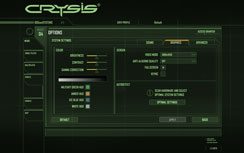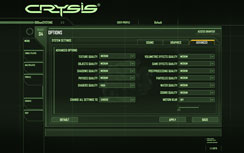Crysis
Publisher: Electronic ArtsWhat can we say about this game that hasn't been said already? Crysis was probably the most anticipated game on the PC last year and was released on November 16th 2007.
Crysis is seen by many as the poster boy for DirectX 10 and it will make your system cry, quite literally – it's a monster! It doesn't come as much of a surprise then, that the graphics are something special – they're above and beyond anything we've ever seen before in a PC game.
We tested the game under both DirectX 9.0 and DirectX 10 with the 1.1 patch applied. We used a custom timedemo recorded on the Harbor map which is more representative of gameplay than the built-in benchmark that renders things much faster than you're going to experience in game. We found that around 30 fps in our timedemo was sufficient enough to obtain a playable frame rate through the game. It's a little different to other games in that the low frame rates still appear to be quite smooth.
For our testing under both DirectX 9.0 and DirectX 10, we set the majority of the in-game settings to medium, with shaders and sound set to high. Because of how intense the game is, we tested with both anti-aliasing and anisotropic filtering disabled on these mid-range cards – but of course, you can enable AA if you want to sacrifice some other in-game details in order to get a playable frame rate. There is currently no support for anisotropic filtering in the game, but you can still force it from the driver control panel.
DirectX 9.0
DirectX 10
What's interesting here is that, despite the modest overclock, BFG Tech's card sits pretty much in between the Zotac GeForce 9600 GT AMP! Edition and the reference-clocked GeForce 9600 GT. The performance difference isn't particularly massive either - you're talking a couple of frames per second at worst.
That doesn't really make a difference to gameplay until you sit at 1680x1050 0xAA 0xAF in DirectX 10 mode, as it's not until then that the card's average frame rate falls below 30 fps. And even then, it only drops to 29 frames per second. As such, I'm not sure you'd notice a massive amount of difference between BFG Tech's and Zotac's cards.
While we're talking about the BFG Tech 9600 GT OC's performance at 1680x1050 in DirectX 10 mode, it's worth noting that this is the first time that the competition from ATI's partners really comes into play. Both the Radeon HD 3870 and the HIS Radeon HD 3850 IceQ 3 TurboX 512MB cards deliver almost identical frame rates, while the PowerColor Radeon HD 3850 Xtreme is just one frame per second slower. Minimum frame rates are appreciably lower on these cards though, with interestingly the worst hit being the 3870. At lower resolutions (and under DirectX 9.0 for that matter), the 9600 GT is a superior card.

MSI MPG Velox 100R Chassis Review
October 14 2021 | 15:04











Want to comment? Please log in.